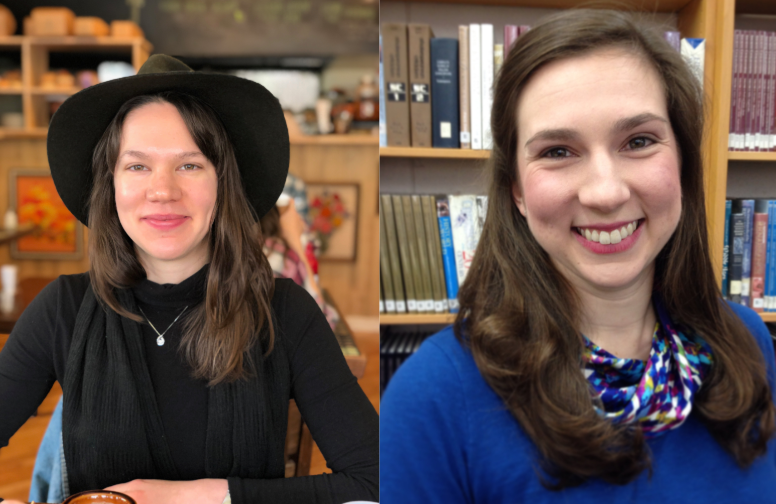Love’s labor is not lost with Shakespeare
William Shakespeare — poet, playwright, and perhaps love guru — is known worldwide for his literary genius. Two academics in the Dept. of English examine how Shakespeare portrayed love and how relevant that portrayal is to us today.

By Hannah LeGare ’19
‘The course of true love never did run smooth,’
‘Who ever loved that loved not at first sight?’
These famous lines of Shakespeare likely ring true to anyone who has been crossed, trapped, or desperate in love. And these words were spoken over 400 years ago…
This Valentine’s Day, the day that celebrates all things romantic, the College of Liberal Arts looks at William Shakespeare, the poet and playwright, whose writing has captured the hearts of millions around the world.
His prolific works have certainly captured the hearts of two academics in the Department of English. Lecturer Dorothy Todd and assistant professor Heidi Craig devote their scholarships to the Bard and his many sonnets, plays, and masterpieces. Todd’s research focuses on conceptions of time and temporality in Shakespeare’s drama, and how his plays engage with the early-modern period’s understandings of time, especially in the final years of Queen Elizabeth I’s reign. Craig researches the relationship between Shakespeare’s written plays and their staged performances, and how Shakespeare and drama more generally are reconceived between 1642 and 1660, when the public performance of plays was outlawed in England.
On and off the stage, Shakespeare’s plays and poems present robust images of love and romance in the early modern period. Todd and Craig are eager to share.
‘A heart to love, and in that heart, Courage, to make’s love known’
According to Todd and Craig, Shakespeare’s attracted so much attention relative to his peers that he was called an “upstart crow,” as he challenged them and sometimes stole the literary and theatrical spotlights. His work was prized for its exceptional analyses of history, societal norms, and basic human experiences — including his treatment of love, both happy and otherwise.
“Shakespeare gets to the hard truths of many relationships and the human experiences of love,” said Craig.
Most, if not all, of Shakespeare’s plays include different interpretations of love and romance from brotherly love to passionate love, and anything in-between.
“You can find the type of love you are looking for in Shakespeare’s texts,” said Todd. “It is not just one view or perception of love; it runs the gamut of different kinds of experiences of love.”
Craig states that, along with romantic love, Shakespeare’s plays also depict love in ways the reader might not expect. For example, in the tragedy King Lear, Shakespeare creates a poignant expression of familial love when King Lear is reunited with his estranged daughter, Cordelia. At the end of the play, Cordelia dies and her father dies of a broken heart.
“Shakespeare shows the close connection between love and vulnerability; when you love someone and you lose them, it can be tragic” said Craig. “Shakespeare capture’s love’s psychological complexity.”
‘And yet, by heaven, I think my love as rare, As any she belied with false compare’
Shakespeare’s treatment of love is also presented in his poems. In the Sonnets, he takes the standard convention of a blazon, a poetic mode where the speaker catalogs the physical attributes of a subject (usually a female), and subverts it. Instead of idealizing the beloved and praising her conventionally attractive appearance, the speaker of the sonnets highlights her physical flaws.
In Shakespeare’s famous Sonnet 130 “My mistress’s eyes are nothing like the sun,” the speaker works down his lover’s body and draws negative comparisons to her eyes, hair, cheeks, and voice; he even says she has bad breath. Todd remarks that while this may be viewed as misogynistic, the speaker tells his love that she does not have to fit into conventional standards of early modern beauty — she can be herself.
“The speaker is able to see his lover for who she truly is and accepts her as someone real,” said Todd. “He sees her imperfections and loves her nonetheless. In fact, the sonnet concludes with the speaker commenting on the rarity of their love precisely because it is not rooted in false or unrealistic comparisons.”
When Shakespeare participates in literary traditions, he demonstrates his dexterity with the tradition and then turns it on its head — like a blazon to an anti-blazon. Once again, the “upstart crow” deftly highlights the ambiguity of love. He doesn’t tell his audience what to think, but to think differently.
‘Thou and I are too wise to woo peaceably’
Craig states that Shakespeare subverts expectations in writing, including in his representation of love.
“Most of the time, you do not get the happily ever after with Shakespeare. He presents multidimensional aspects of love, with all of its messy realities and disappointments,” said Craig.
Even in the misconceptions about Shakespeare and his treatments of love, we still get those messy realities and disappointments. From songs about Romeo and Juliet (listen to Taylor Swift’s “Love Story”) to a movie about Shakespeare in love (wisely called Shakespeare in Love), society is fascinated with tragic or comedic elements of love that may not completely be true.
“Romeo and Juliet isn’t a love story, but it is more accurately a story about dysfunctional families and a dysfunctional town. Nevertheless, the moments of romance felt in the play still gives us those warm fuzzy feelings about young love, even though we know Romeo and Juliet’s story is a tragic one,” said Todd.
In reality and in misconception, Shakespeare is a master of the ages. Today, Shakespeare’s writings validate the feelings of young people in or out of love — even though the words were written hundreds of years ago. It shows that love truly transcends time.
‘If music be the food of love, play on’
Whether you are a Shakespeare buff or not, his comedies, tragedies, and histories have been globally adapted and embraced. At Texas A&M, Shakespeare is known and loved.
“Texas A&M is a major center for the study of Shakespeare,” Craig said. “We are on the vanguard of the latest research in Shakespeare.”
Craig is an editor of the World Shakespeare Bibliography (WSB), a searchable electronic database consisting of the most comprehensive record of Shakespeare-related scholarship and theatrical productions published or produced worldwide from 1960 to the present. And it is housed at Texas A&M. The WSB is an important resource for any Shakespeare aficionado.
Todd teaches Shakespeare to a wide range of students, including students who are not liberal arts majors. She uses Shakespeare as a foundational text to build her students’ skills, critical thinking, and knowledge. The Bard isn’t just for English majors, but can be enjoyed by all.
Craig and Todd agree that Shakespeare’s work is widely adaptable. Many of his plays and poems seem to anticipate contemporary human feelings and interactions; his works continue to speak to us over four centuries after their composition.
“The allure of Shakespeare continues to stretch our creative instincts, challenge our conceptions about love, and help us to understand each other better,” said Todd.
Maybe this Valentine’s day, instead of a box of chocolates and a fancy dinner, read one of Shakespeare’s plays, and woo with his words of love.
Want to learn more from our knowledgeable College of Liberal Arts professors? Consider taking Shakespeare (ENGL 212) or Studies in Shakespeare (ENGL 412) to discover more about Shakespeare and where you fit into the conversation.


